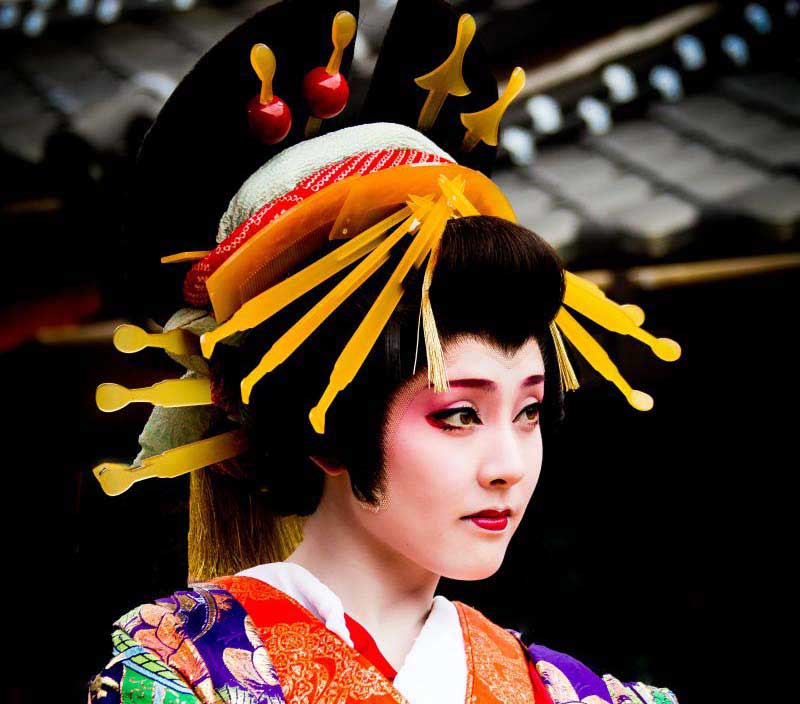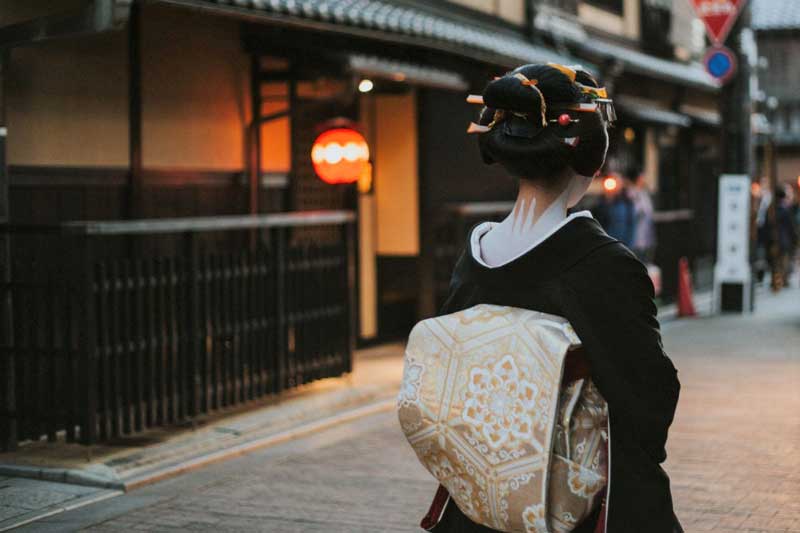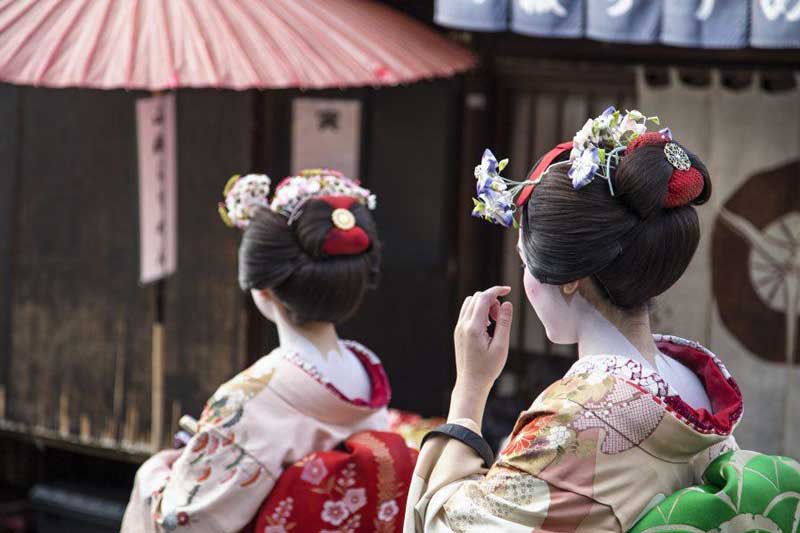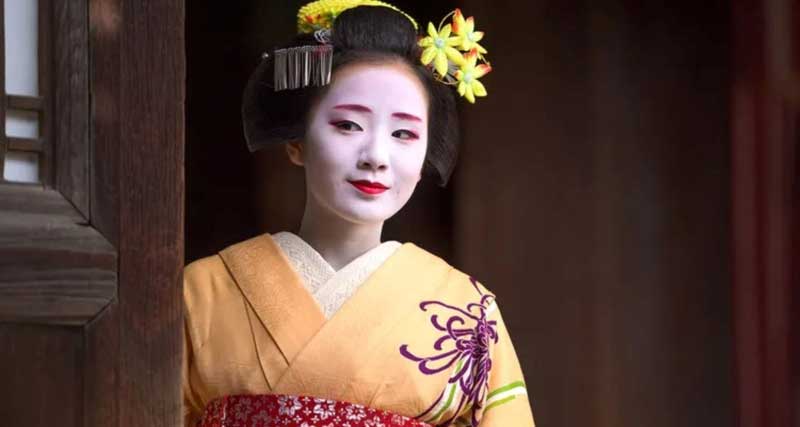
Geisha, one of the oldest cultures and traditional practices of Japan, are a class of female professional entertainers, trained in a variety of Japanese traditional arts, like dancing, singing and playing traditional musical instruments, as well as the art of hospitality, including playing games and keeping the visitors engaged in witty conversation in an intimate atmosphere of chic and gaiety, to make them free from tension and help them to rejuvenate their body and mind.
They also often entertain at parties known as ozashiki, mostly for the entertainment of wealthy clientele, as well as perform on a stage and at festivals. Apart from entertaining people, they are also adept at flower arranging, performing the tea ceremony and calligraphy. Their appearance is characterised by their long, exquisite kimono, traditional hairstyle and oshiroi makeup, a powder foundation, which is traditionally used by the Kabuki actors of classical Japanese dance drama.

The geisha system is thought to have emerged in the 17th century to provide a separate class of traditional entertainers, demarcated from courtesans and prostitutes, who usually serve the need of the affluent nobility and samurai. But although prostitution was never been widely accepted as part of a geisha's traditional role and ideally, the two occupations should not be conflated, especially in modern times, since the law officially maintained a distance between prostitutes and geisha, some girls volunteered, either being attracted by the glamour of the life or were forced to accept it under compulsion, due to various socio-economic reasons.
Besides, often a geisha finds little choice, but to sell her virginity several times to pay off her incumbent debts to the mother of the house.


The Japanese word geisha, also often referred to as Geiko or Geigi, is closely associated with the word gei, which stands for entertainment, indicating the true purpose of a Geisha. However, Geisha, Geiko and Geigi differ slightly in their purposes. The word Geisha is made of two parts and while gei means entertainment, sha stands for a person. Similarly, ko in Geiko means child and the gi in Geigi refers to someone who often plays music and sings. Although Western culture often considers all of these practices under the common label of Geisha, they do differ slightly and are considered very different roles in the Japanese culture.

In the early days, some of the saburuko or the serving girls, members of the families displaced by war, offered sexual services for money, while others with a better education supported themselves by entertaining at high-class social gatherings. During the Heian period, running from 794 to 1185, relationships with women, sexual or otherwise, did not emphasise fidelity and men were not constrained to be faithful to their wives.
Much later, the pleasure quarters were built in 1617, designating prostitution illegal beyond those quarters. Though women in the lower ranks of yūjo or the pleasure quarters did not provide as much artistic entertainment as they did sexual, oiran, whilst still prostitutes, included the traditional arts as the main aspect of their entertainment. Soon the pleasure quarters became popular entertainment centres that developed their own additional forms of entertainment outside of sex with the highly accomplished courtesans entertaining their clients by dancing, singing and playing music. In the 1680s, odoriko or the chaste dancers became popular entertainers and were often paid to perform in the private homes of upper-class samurai and by the early 18th century, many of the odoriko also began to offer sexual services to their clients, along with their chaste performances. The first woman known to have called herself geisha, roughly around 1750, was a prostitute, by the name Kikuya from Fukagawa, who had become a skilled singer and shamisen, a three-stringed traditional Japanese musical instrument, player and became an immediate success, bringing greater popularity to the idea of female geisha. Since then, the popularity of geisha grew quickly and today, they are vital to upholding traditional Japanese culture.


The main duty of a geisha is to entertain her wealthy clients, providing them with an atmosphere of chic and gaiety, but to become a full-time Geisha, she has to study the duties and responsibilities of Geisha entertainment, as well as learn to sing and dance. Until the 20th century, geisha training began at a very tender age, around the age of six, when girls were sent to a geisha house, known as Okiya, by their respective parents, in exchange of some money as fees, where she was to stay with their seniors, taught, trained, fed and clothed for years. After passing the Shikomo examination, she becomes a maiko and after undergoing another five years of practical training, she emerges as a full-fledged geisha, permitted to earn money to repay her parents’ debt. But today, girls must be graduated from middle school and then take their personal decision to get the training to become a geisha and enter the professional world of entertainment. Regulations were put in place to prevent geishas from forming personal relationships with customers, but besides providing entertainment and social companionship, geisha sometimes maintained sexual relationships with their clients.


The makeup of geisha, although seems simple, takes time to make it perfect and is applied before dressing to avoid dirtying the kimono. During the process, the face and neck are covered with a white powder base paste called oshiroi and the patterns on the back of the neck forming a W or V shape, is left untouched, to bring prominence to this traditionally erotic area. They colour their eyebrows black, but a maiko, who has not yet completed the training, but has developed her talents to entertain guests with skilful dance moves and is expected to work and entertain guests, applies red eye shadow for a more dramatic and effective look. For their iconic red lips, only geishas apply colour to the upper and the lower, while a maiko applies colour only to the lower lip to make her appear more innocent. However, for both, the bottom lip is drawn with a curved stripe to create the illusion of a flower bud.


The iconic hairstyles of geisha are intricately designed and take hours to complete and to keep the hair-do undisturbed, they cannot wash their hair for days together and sleep on special pillows. After arranging the hair in a stylised chignon, they usually decorate it with some ornaments called kanzashi, to give it a final touch. Different hairstyles and hairpins signify different stages of a geisha and they are also related to the seasons, for example, plum ornaments are used in February, while pink sakura ornaments are reserved for April. The colour, patterns and style of their kimono are also dependent on the seasons and the event they attend.

By the late 20th century, the number of geisha dwindled drastically to only around a thousand, due to the easy availability of more casual forms of sex in postwar Japan. The remaining members of the clan became mostly confined to the big cities like Tokyo, Kanazawa and Kyōto, supported by the wealthy businessmen and the influential politicians, while the bar hostesses took the geisha’s role in the smaller cities to satisfy the expectation of the ordinary Japanese businessman. A geisha is free to marry, but before entering into the new life, she retires from the profession and if she chooses to remain single, she usually retires as a restaurant owner, teacher of music or dance or a trainer of future geisha.